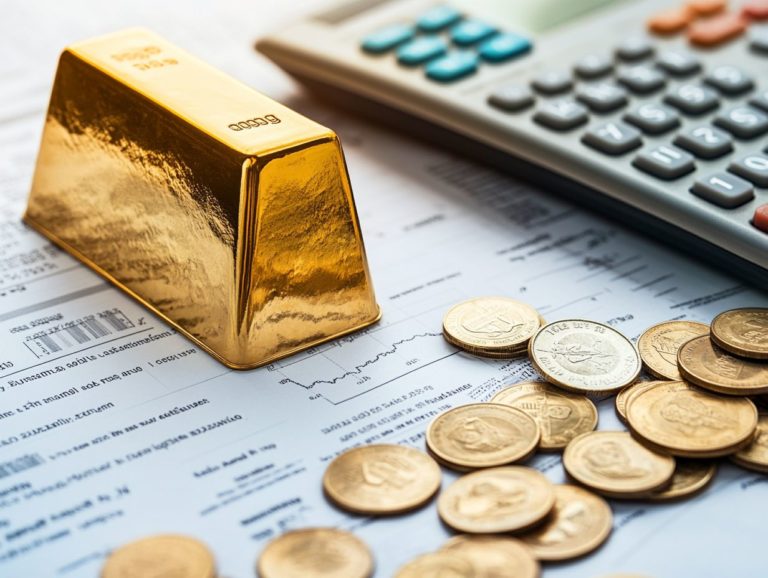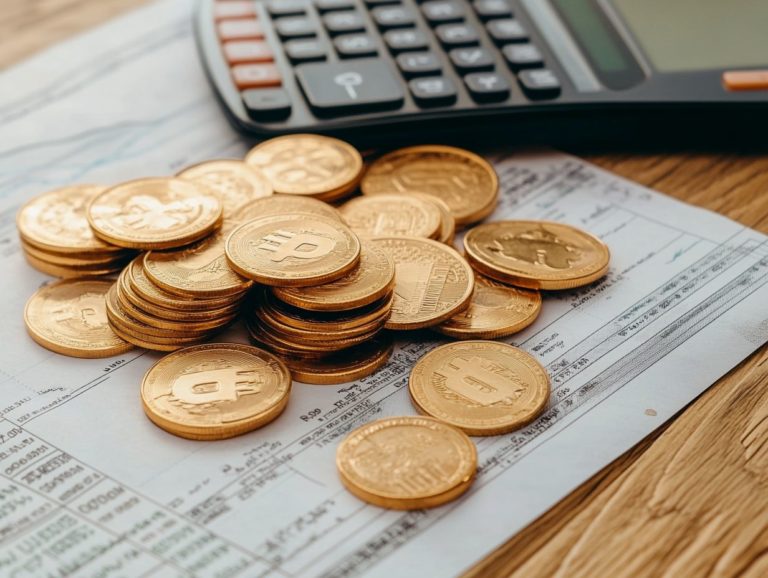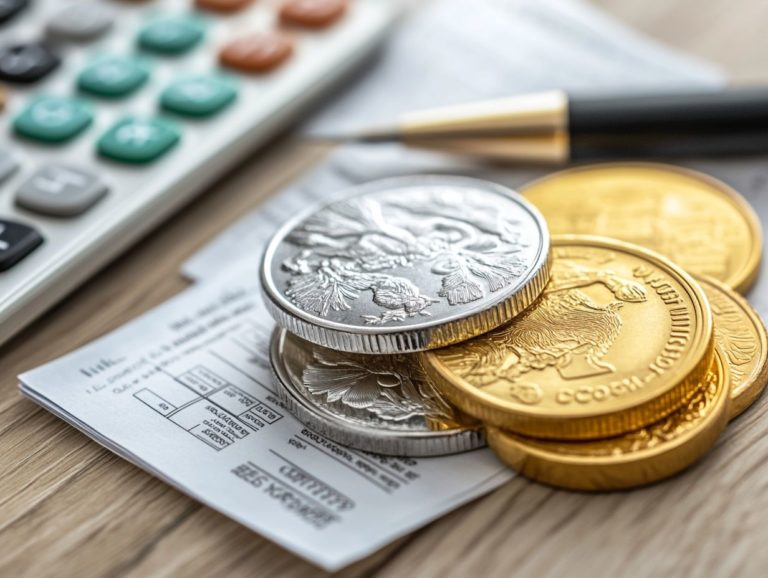Understanding Tax Brackets for Precious Metals Investors
Investing in precious metals can be rewarding. However, understanding the tax implications can be challenging.
This article explains essential concepts, such as tax brackets and capital gains tax, to help you make informed investment decisions.
You will explore the nuances of different types of precious metals and discover tax strategies to maximize your savings and minimize your financial burdens.
We highlight common pitfalls to avoid, ensuring your investment journey is both profitable and compliant.
Jump in now to take charge of your financial future!
Contents
- Key Takeaways:
- Tax Brackets for Precious Metals Investors
- Calculating Taxes on Precious Metals Investments
- Tax Strategies for Precious Metals Investors
- Common Tax Mistakes to Avoid
- Frequently Asked Questions
- What are tax brackets and how do they apply to precious metals investors?
- Are there different tax brackets for different types of precious metals?
- What are the current tax brackets for precious metals investors?
- Do I have to pay taxes on precious metals if I hold onto them instead of selling?
- Can I lower my tax bracket by investing in precious metals?
- Are there any tax benefits for precious metals investors?
Key Takeaways:
- Understand tax brackets and their effect on your precious metals investments. Different tax brackets have distinct rates, making it crucial to know your income bracket for accurate tax calculations.
- Capital gains tax is the tax you pay on profits from selling precious metals. The type of metal and its holding period determine the applicable tax rate.
- Maximize tax savings by diversifying your precious metals portfolio and using tax-advantaged accounts like IRAs. Reduce your tax burden by offsetting gains with losses and taking advantage of deductions and credits.
Tax Brackets for Precious Metals Investors
Understanding tax brackets is crucial for precious metals investors. They show how different income levels from investments in assets like gold and silver are taxed under various IRS guidelines, impacting your overall tax liabilities.
These brackets dictate how much tax you owe based on your income level and can vary by state, adding complexity to your investment journey.
By analyzing the relevant tax rates and brackets, you can create effective investment strategies that align seamlessly with your financial goals and tax responsibilities.
What are Tax Brackets?
Tax brackets are income ranges that dictate the rate at which your earnings are taxed, as specified by the IRS. This applies to both ordinary income and capital gains tax obligations.
These brackets create a tiered system, meaning that as your income rises, you face progressively higher tax rates. This is particularly important when considering your overall financial strategy, especially if you’re investing in precious metals.
As an investor, pay close attention to how these brackets impact capital gains from selling precious metals. For a deeper insight, refer to understanding the tax code for precious metals investments. Gains can be classified as either short-term or long-term, and understanding these categories is essential.
Short-term capital gains from assets held for one year or less are taxed at your ordinary income tax rate. In contrast, long-term capital gains often benefit from lower tax rates. This distinction adds complexity to managing your tax liability across different income types.
Calculating Taxes on Precious Metals Investments
Calculating taxes on your precious metals investments requires a nuanced understanding of several financial factors. You need to determine the cost basis for your gold and silver holdings and assess the market value at the time of sale.
Also, think about how your overall investment portfolio may be affected when reporting gains or losses to the IRS during tax season. It’s essential to navigate these intricacies to ensure you are fully informed and compliant.
Understanding Capital Gains Tax
Capital gains tax is a tax on profits made from selling assets, including precious metals like gold and silver. Understanding the differences between long-term and short-term gains is essential for managing your tax liabilities.
Short-term capital gains apply to assets held for a year or less. They typically get taxed at your ordinary income rate, which can lead to a higher tax burden.
In contrast, long-term capital gains enjoy lower tax rates, making them a more attractive option for those committed to sustained investments.
If you’re investing in precious metals, it s crucial to keep these rates in mind. A quick sale of physical gold could land you with a hefty tax bill. Holding those assets for over a year can significantly reduce your tax implications.
For instance, selling gold coins for a profit after just six months means that profit is taxed as ordinary income. However, if you hold onto those coins for more than a year before selling, the proceeds may qualify for a reduced capital gains rate, optimizing your net returns.
Investing through ETFs (Exchange-Traded Funds) also comes with its own tax consequences, depending on how long you hold them. Generally, longer-term strategies tend to be more tax-efficient, making them a wise choice for those looking to maximize their investment outcomes.
Considerations for Different Types of Precious Metals
When considering taxes on precious metals, it s crucial to recognize that different types such as gold, silver, and platinum carry unique tax implications. This is especially true when you factor in collectible assets and the specific investment vehicles you use for trading these metals.
Understanding how these precious commodities are categorized under tax laws is essential. For example, gold and silver may be classified as collectibles, leading to higher capital gains tax rates.
Conversely, other investment forms like ETFs or mutual funds might offer more favorable tax treatments, depending on their structure. Sales tax on these transactions can vary considerably from state to state, adding another layer of complexity to your investment strategy.
Stay informed about local regulations that could impact your bottom line. Some states might provide exemptions for certain purchases, while others enforce strict taxation rules that could ultimately influence your overall approach to investing in precious metals.
Tax Strategies for Precious Metals Investors
Implementing effective tax strategies for precious metals investments is crucial for maximizing your tax savings and minimizing the overall tax burden tied to your investments in gold, silver, and other precious metals.
By leveraging the tax advantages available through retirement accounts such as IRAs, you can significantly enhance your investment strategy and safeguard your wealth more efficiently.
Maximizing Tax Savings
Maximizing tax savings as a precious metals investor requires you to grasp effective investment strategies, such as recognizing capital losses and implementing loss offsets to minimize taxable gains.
By strategically planning the timing of your sales, you can align your transactions with lower tax brackets, thereby reducing your overall tax liability. For instance, selling in a year when your income is lower can lead to a more advantageous tax outcome.
Understanding how various types of precious metals like gold, silver, and platinum are treated from a tax perspective can further enhance your strategies. It s also vital to consult with tax professionals who can provide you with personalized advice.
They can help you navigate the complexities of regulations and ensure that every opportunity for savings is effectively leveraged. Act now to optimize your investment strategy and save on taxes!
Reducing Tax Burden
Reducing the tax burden associated with your precious metals investments can be accomplished in various ways.
Begin by evaluating dealer commissions and understanding how ordinary income impacts your overall tax liabilities.
It s crucial to pay attention to the types of transactions you engage in and their timing.
These elements can significantly influence your tax outcomes.
For instance, long-term holdings often provide more favorable tax rates compared to short-term gains.
Factoring in dealer commissions is important, as they represent a legitimate expense that can effectively lower your taxable income.
By meticulously tracking these costs and employing strategies like selling losing investments to reduce taxes on profits, you can optimize your financial landscape.
This ensures that you retain more of your returns while deftly navigating the complexities of tax obligations related to precious metals.
Common Tax Mistakes to Avoid
Navigating taxes on your precious metals investments can lead to common pitfalls.
Steer clear of these to protect your investments!
It’s vital to pay close attention to reporting requirements and adhere strictly to IRS tax obligations.
Failing to do so could result in penalties or even increased tax liabilities that could significantly impact your investment returns.
Staying informed and diligent is key to safeguarding your financial interests in this arena.
Costly Errors in Taxation on Precious Metals
Costly errors in taxation on precious metals can occur when you fail to report your taxes properly or misinterpret how ordinary income is treated.
This oversight can lead to significant financial consequences for you as an investor.
For example, if you mistakenly classify the sale of collectible gold coins as long-term capital gains instead of ordinary income, you could face hefty tax penalties and interest.
Not reporting gains accurately might prompt the IRS to audit you, resulting in expensive fines.
These pitfalls highlight the importance of collaborating with tax professionals who specialize in the latest IRS regulations.
By understanding the complexities of tax laws, you protect yourself from severe financial missteps and ensure compliance, thereby safeguarding your investment returns.
This video provides valuable insights into managing taxes on precious metals. Be sure to check it out!
Frequently Asked Questions
What are tax brackets and how do they apply to precious metals investors?
Tax brackets are income levels that determine your tax rate. They affect how much tax you pay on profits from buying and selling precious metals.
Are there different tax brackets for different types of precious metals?
No, tax brackets are based on total income earned, regardless of the source. This means that profits from buying and selling gold, silver, or other precious metals will be taxed at the same rate as any other income.
What are the current tax brackets for precious metals investors?
The tax brackets for precious metals investors are the same as the regular tax brackets for individual taxpayers. Tax rates vary each year; consult the IRS or a tax professional for current rates.
Do I have to pay taxes on precious metals if I hold onto them instead of selling?
No, taxes are only paid on the profits made from buying and selling precious metals. If you hold onto your precious metals without selling, you will not owe any taxes on them.
Can I lower my tax bracket by investing in precious metals?
Investing in precious metals can potentially lower your tax bracket, as any profits made from buying and selling precious metals will be considered as part of your total income. However, this depends on your individual financial situation and tax laws in your country.
Are there any tax benefits for precious metals investors?
Yes, there are certain tax benefits available for precious metals investors, such as the ability to deduct certain expenses related to your investment, like storage fees. It is important to consult with a tax professional for specific guidance on tax benefits for your individual situation.














